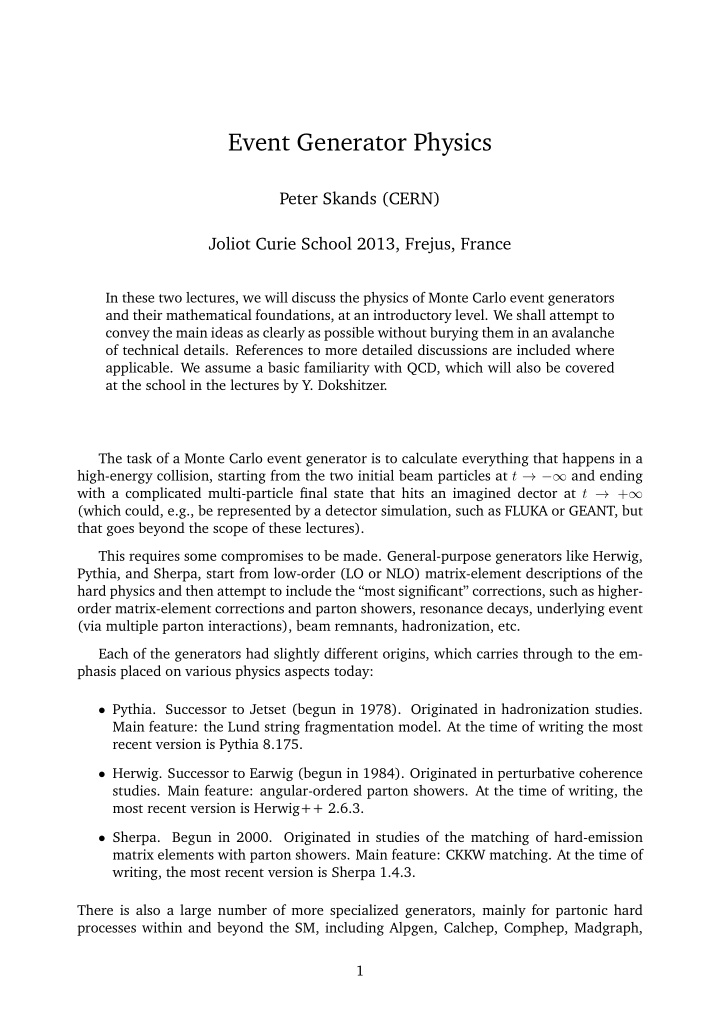



Event Generator Physics Peter Skands (CERN) Joliot Curie School 2013, Frejus, France In these two lectures, we will discuss the physics of Monte Carlo event generators and their mathematical foundations, at an introductory level. We shall attempt to convey the main ideas as clearly as possible without burying them in an avalanche of technical details. References to more detailed discussions are included where applicable. We assume a basic familiarity with QCD, which will also be covered at the school in the lectures by Y. Dokshitzer. The task of a Monte Carlo event generator is to calculate everything that happens in a high-energy collision, starting from the two initial beam particles at t → −∞ and ending with a complicated multi-particle final state that hits an imagined dector at t → + ∞ (which could, e.g., be represented by a detector simulation, such as FLUKA or GEANT, but that goes beyond the scope of these lectures). This requires some compromises to be made. General-purpose generators like Herwig, Pythia, and Sherpa, start from low-order (LO or NLO) matrix-element descriptions of the hard physics and then attempt to include the “most significant” corrections, such as higher- order matrix-element corrections and parton showers, resonance decays, underlying event (via multiple parton interactions), beam remnants, hadronization, etc. Each of the generators had slightly different origins, which carries through to the em- phasis placed on various physics aspects today: • Pythia. Successor to Jetset (begun in 1978). Originated in hadronization studies. Main feature: the Lund string fragmentation model. At the time of writing the most recent version is Pythia 8.175. • Herwig. Successor to Earwig (begun in 1984). Originated in perturbative coherence studies. Main feature: angular-ordered parton showers. At the time of writing, the most recent version is Herwig++ 2.6.3. • Sherpa. Begun in 2000. Originated in studies of the matching of hard-emission matrix elements with parton showers. Main feature: CKKW matching. At the time of writing, the most recent version is Sherpa 1.4.3. There is also a large number of more specialized generators, mainly for partonic hard processes within and beyond the SM, including Alpgen, Calchep, Comphep, Madgraph, 1
Whizard, and others, and a few that offer alternative shower models, such as Ariadne and Vincia. Finally, there are the generators which are mostly used for soft QCD physics pro- cesses (such as diffraction, minimum-bias, and cosmic-ray physics), which include Dpmjet, Epos, Phojet, Qgsjet, and Sibyll. A useful and up-to-date set of lecture notes covering QCD in the context of event gen- erators are the ones from the TASI lectures last year [1]. There is also the recent and very comprehensive review of event generators for LHC physics by the MCnet collaboration of MC authors [2]. This also contains brief descriptions of the physics implementations of each of the main general-purpose event generators on the market, together with a guide on how to use (and not use) them in various connections, and a collection of compar- isons to important experimental distributions. Finally, the newly updated 2012 edition of the Review of Particle Physics (RPP) also contains a more condensed review section on general-purpose Monte Carlo models [3]. Other useful and pedagogical reviews on event generators are contained in the 2006 ESHEP lectures by T. Sj¨ ostrand [4], with a more recent update in [5]. The basics of random numbers and Monte Carlo techniques for numerical integration and stochastic simulation are very well described in the book by F. James [6]. A more recent and particle-physics oriented short introduction is this one by S. Weinzierl [7]. The so-called veto algorithm, which is crucial to all parton-shower applications, is described in some detail in the MCnet review mentioned above [2]. Since event generators must describe everything in explicit detail, they also necessarily cover less well understood physics, such as hadronization and the underlying event. In the absence of a complete solution, they use QCD-inspired phenomenological models to describe these components, such as the Lund String Model [8]. Though these models are far from arbitrary, they are formulated in terms of effective parameters which must be determined from data. Especially to non-experts, the most sophisticated physics descriptions may appear to have bewilderingly many such parameters, leading to the impression that the model could be “tweaked” or “tuned” into agreement with virtually any measurement. I will emphasize in these lectures that the bulk of the physics is governed by a very few, very important, parameters, and that the lack of a perturbative solution does not imply a complete lack of predictive power; there are still strong constraints imposed by causality, Lorentz invariance, energy and momentum conservation, unitarity, sum rules, etc. A recent overview of the physics considerations involved in the process of “Monte Carlo tuning” for hadron collisions can be found in [9]. A comprehensive online repository of MC-to-data comparisons can be found at http://mcplots.cern.ch . References [1] P. Skands, “Introduction to QCD,” 1207.2389 . Lecture notes from TASI 2012. [2] MCnet Collaboration, A. Buckley, J. Butterworth, S. Gieseke, D. Grellscheid, S. H¨ oche, et al. , “General-purpose event generators for LHC physics,” Phys.Rept. 504 (2011) 145–233, 1101.2599 . 2
[3] Particle Data Group Collaboration, J. Beringer et al. , “Review of Particle Physics (RPP),” Phys.Rev. D86 (2012) 010001. [4] T. Sj¨ ostrand, “Monte Carlo Generators,” hep-ph/0611247 . [5] T. Sj¨ ostrand, “Monte Carlo Tools,” 0911.5286 . [6] F. James, “MONTE CARLO THEORY AND PRACTICE,” Rept.Prog.Phys. 43 (1980) 1145. [7] S. Weinzierl, “Introduction to Monte Carlo methods,” hep-ph/0006269 . [8] B. Andersson, “THE LUND MODEL,” Nucl.Phys. A461 (1987) 513C–520C. [9] P. Z. Skands, “Tuning Monte Carlo Generators: The Perugia Tunes,” Phys.Rev. D82 (2010) 074018, 1005.3457 . 3
Recommend
More recommend